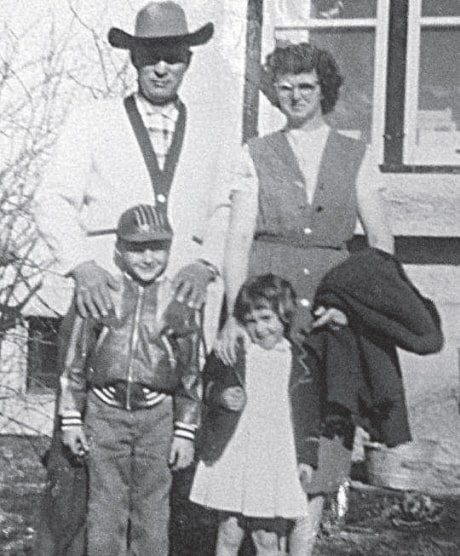A delightful big book full of stories and pictures is now on display at the Fort Ostell Museum that depicts the long and colorful history of the Dakota district, which began in the rugged country out west of Ponoka way back in 1900 and has been flourishing ever since. Reflections in your Ponoka News is pleased to feature many of the families and individuals who have worked and played together over the years to make the very best out of ‘country living’, while establishing our proud heritage along the way.
The Tiltgen family
Baptiste (Bob) Tiltgen was born in Luxemburg in 1879, immigrated to Kansas and Nebraska to join his uncle and aunt at the age of 17, and then came to Alberta in 1900. He worked on the highway bridge at Fort MacLeod and later worked for Tom McKelvey of Ponoka, and was in on the last log drive down the Battle River into the local mills.
He homesteaded the S.W. 16-44-27 in the Chesterwald area, married Annie Sisel of Fertile Forest in 1907, and then moved onto the Joe Allen homestead in the Dakota district in 1911, which became their lifetime home. Bob was well known for raising good horses and as a noted teamster, who for many years offered his well matched black team of horses and democrat as a hearse for countless district funerals. Always a willing community worker in many projects, he served as a councillor for the municipality from 1926 until his death in 1936 at the age of 56 years. Mrs. Tiltgen was a Charter member of the Dakota Church Ladies’ Aid, was a wonderful homemaker famous for her prune buns, and together they raised their family of Emil, Robert J, Frank J, Helen, John, and Mary. Annie retired to Ponoka and passed away in 1949 at the age of 68 years.
Emil Tiltgen was born on December 1, 1908 at his parents’ homestead in the Chesterwold district, later attended the Dakota School, and was one of the early graduates of the Olds School of Agriculture in 1931. An avid farmer, he was always an inspirational leader in the community, serving for many years as the Secretary of the Ferrybank Hall Board and later succeeded his father Bob as a councillor and eventually served as the Reeve of the municipality. Emil was also a Charter member of the Ponoka Lion’s Club as well as an avid curler, including a member of the Ponoka Curling Club, and later served as the President of the new and popular Dakota Curling rink.
He married Winnifred Godard Hedrich in 1945, and together they welcomed their children Jim, Mabel, Ann, Bob, and Linda. After Emil’s death in 1955, the family continued to live in the Dakota district, with Winnifred later moving to Ponoka and working in the accounting office at the Alberta Hospital. Jim and Bob carried on the farming tradition, establishing a partnership in the dairy business as well as raising purebred polled Herefords.
John Tiltgen and his wife, the former Jean Archibald were married in 1948 and lived on their Dakota farm home for many years. For many years, John raised purebred Hereford cattle, which he showed throughout central Alberta, and also conducted buying tours with the Russians, which helped to set up lucrative export programs in the 1960s. He was also an avid curler and trapshooter and took part in many other sports.
Jean taught school at Dakota before her marriage, and was a very active member of the Dakota Curling Club and the Ponoka United Church Women. Their two children, Jackie and Anne, attended Crestomere School until 1968, then transferred to Sylvan Heights and finished their high school education in Ponoka.
The George Winslows
In 1901, George Winslow Sr. came to the Dakota district from South Dakota to file on a homestead S.W. 35, where he bought two Canadian Pacific Railway quarters. In the spring of 1902, he brought up a carload of machinery and horses to put in his first crops, and then returned to the U.S. in the fall for another carload of goods along with his wife Maggie and five children.
One of the feature stories in the Oct. 31, 1902 edition of the Ponoka Herald reported that George Winslow had arrived in town with his family and effects from Madison, South Dakota. He has recently erected near Ferrybank one of the best houses and barns in this part of Alberta, and is now busy moving his effects. Among his many possessions is his powerful 14 horse-power threshing machine, for which the people in the district have been anxiously awaiting. His daughter Bertha recalled the gruelling preparation that the women had to make before leaving for Canada, including sewing clothing and quilts, as well as enough food for the long trip.
Their children: Bertha, George Jr., Grace, William, and Fred attended the first Dakota School when it opened in 1902, and their mother served on the board. Most of them lived in the district for many years, and have proudly carried on the family farming tradition for several decades. George Winslow passed away in 1927 and Maggie Winslow in 1928. Everyone is welcome to drop into the Fort Ostell Museum in the Ponoka Lion’s Industrial Park, where they are welcome to browse through the Dakota memories, as well as all of the countless artifacts of our colorful and amazing history.
